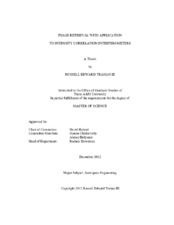| dc.description.abstract | As astronomers and astrophysicists seek to view ever-increasingly distant celestial objects, the desired angular resolution of telescopes is constantly being increased. Classical optics, however, has shown a proportional relationship between the size of an optical telescope and the possible angular resolution. Experience has also shown that prohibitive cost accompanies large optical systems. With these limitations on classical optical systems and with the drastic increase in computational power over the past decade, intensity correlation interferometry (ICI) has seen renewed interest since the 1950’s and 60’s when it was initially conceived by Hanbury Brown and Twiss. Intensity correlation interferometry has the advantage of less stringent equipment precision and less equipment cost when compared to most other forms of interferometry. ICI is thus attractive as a solution to the desire for high angular resolution imaging especially in space based imaging systems.
Optical interferometry works by gathering information about the Fourier transform of the geometry of an optical source. An ICI system, however, can only detect the magnitude of the Fourier components. The phase of the Fourier components must be recovered through some computational means and typically some a priori knowledge of the optical source.
This thesis gives the physics and mathematical basis of the intensity correlation interferometer. Since the ICI system cannot detect the phase of an optical source's Fourier transform, some known methods for recovering the phase information are discussed. The primary method of interest here is the error-reduction algorithm by Gerchberg-Saxton which was adapted by Fienup to phase retrieval. This algorithm works by using known qualities of the image as constraints; however, sometimes it can be difficult to know what these constraints are supposed to be. A method of adaptively discovering these constraints is presented, and its performance is evaluated in the presence of noise. Additionally, an algorithm is presented to adapt to the presence of noise in the Fourier modulus data. Finally, the effects of the initial condition of the error-reduction algorithm are shown and a method of mitigating its effect by averaging several independent solutions together is shown. | en |


